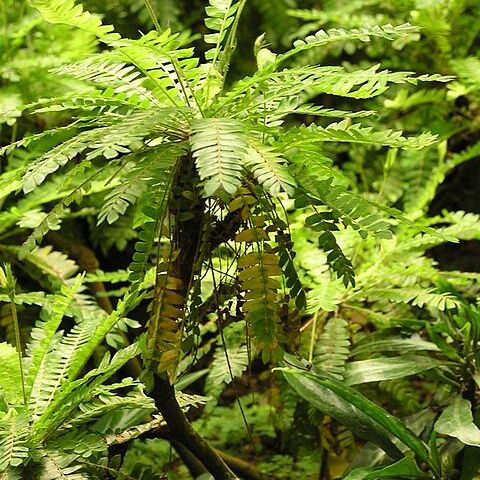Perennial. Stem woody, becoming coarse (not compressible), up to 15 cm, finally (always?) branched, old parts reflexed. Leaves 9-16-jugate; rachis 2½-7 cm, hirsute mainly at the nodes leaflets often overlapping, terminals 4-10 by 2-6 mm, asymmetric, falcate, others smaller, truncate at base, elliptic to oblong, less asymmetric, with median midrib; apex obtuse, apiculate, upper surface sparsely hairy, underneath more so; nerves many. Peduncle 1-3½ cm, up to 7-flowered, appressed-pubescent. Pedicels 1½-3½ mm, club-shaped, shorter than the conspicuous, setaceous, 3-6 mm long bracts. Sepals 6-8 by 1-3 mm, ovate, oblong to lanceolate, apex attenuate, acute, base hairy, in fruit 5-8-nerved, longer than pedicel, 1½-2 times as long as the fruit, equal to ± shorter than the corolla. Petals 7-8 mm, lanceolate, rounded, pink to lavender. Filaments (LF) 2½-3 and 3¾-5 mm, the longer ones with a few cilia. Ovary 2 by 1 mm, apically ciliate; styles (LF) 2-2¾ mm long; stigma subulate, entire; ovules 4-6 per cell. Fruit 3-5 by 2½ mm, apically pu-berulous on the ridges. Seeds 1-6 per cell, 1 by ½ mm, with two longitudinal ridges, in between with ± longitudinal rows of tubercles.
Rhizomatous herb, stems obsolete or to 35 cm tall and woody, to 5 cm diam.; rooting up to 20 cm from the base, sometimes 2-or 4-branched; bark rough, appressed retrorse pubescent, glabrescent; root fibrous, to 10 cm long, twisted, branched. Leaves pseudoverticillate at the end of the stems, 15-30, 9-26 jugate, linear in outline, subcuneate; lower leaflets ovate to subtriangular, asymmetric, 1-2.5 mm long, 1-2.5 mm wide, the middle leaflets subrectangular to subfalcate, 2.5-10 mm long, 1.5-7 mm wide, the terminal leaflets semiobovate, asymmetric, basally truncate to subhastate, 6-11 mm long, 2.5-5 mm wide, the leaflets some-times overlapping, glabrous or sparsely hirsute on one or both sides, hirsute ciliate, obtuse or subacute, the mucro sometimes violaceous, the midrib medial or emerging from nearer the posterior angle, secondary nerves ascending, curved, branched, connected to a marginal nerve; rachis 2-10 cm long, hirsute, more so at the insertion of the leaflets; petiolules 1/4 mm long, thick, fleshy; petiole 1 mm

